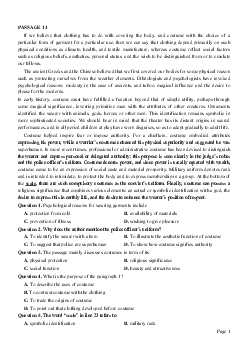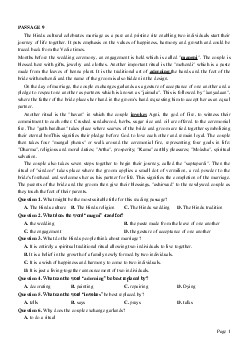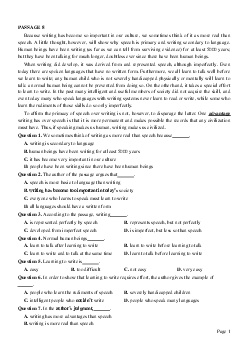




Preview text:
PASSAGE 24
Weekly Reader News heads down under to find out what scientists are doing to save Australia’s koalas.
Koalas are pictured everywhere in Australia – on cleaning products, on boxes of chocolate, on sports team jerseys.
Yet the animals live only in pockets along the east coast. The marsupials once inhabited the entire
coastline. (A marsupials is a mammal that typically carries its young in a pouch.)
The koala’s population dropped after farmers cut down many of the forests where koalas lived and
hunters killed the animals for their fur. Buy the early 1900s, “koalas were basically shot out of south
Australia,” says ecologist Bill Ellis. An ecologist is a scientist who studies the relationships among living
things and their environments.
I recently joined Ellis and his team in a forest on St. Bees Island, 19 miles off the northeastern coast of
Australia, with eight other volunteers. The island is a natural laboratory, yielding findings that may help
protect koalas elsewhere on the continent. Trees Tags
The volunteers combed the island for koalas in the blue gum trees. When we found a koala, we
gathered information about the trees in the area.
Blue gum is a species of eucalyptus tree in which the furry leaf eaters spend most of their time.
Eucalyptus trees are native to Australia, and their leaves are the main food source for koalas. Although
koalas can walk on the ground, they are better suited for life in the canopy, the high cover of branches and leaves in a forest. Goat Trouble?
What has Ellis’s research told him so far? The St. Bees population seems to be healthy. Yet Ellis
wonders whether the koalas might be heading for hard times. The island is overrun with wild goats, and
Ellis thinks the goats are eating the small blue gum trees.
Without those trees, the koalas will run out of food in the future. Ellis hopes more research will help
him understand how to protect the blue gums – and the koalas that depend on them. “I think that’s what
everyone is trying to do – to make a difference,” Ellis says. (Weekly Reader 2007)
Question 1. Though koalas can walk on the ground, they are better suited for life .
A. on island off the northeastern coast
B. in the high cover of branches and leaves in the forest C. by the coastline
D. inside of the blue gum tree
Question 2. Why do you think the koalas no longer inhabit the entire coastline?
A. The koalas have moved to a drier environment.
B. Koalas have been killed by hunters.
C. Koalas have been moved to zoos for protection
D. Disease has caused the koalas to decrease in population.
Question 3. How does the author organize the information in this passage? Page 1
A. The author provides details about the unusual nature and habitat of koalas.
B. The author compares the arguments for and against koalas rescue.
C. The author describes a current problem and investigates research on solutions.
D. The author combines fiction and nonfiction information about koalas to explain their popularity in Australian society.
Question 4. What can be inferred from the information in the second paragraph regarding koalas being
“pictured everywhere” in Australian?
A. Koalas have been found to be good advertisements for products.
B. Koalas are dying out, so pictures are difficult to find.
C. Koalas are well-liked across Australian.
D. Many ecologists are trying to save the koalas.
Question 5. What words could best replace the phrase “yielding findings” in the paragraph 4?
A. producing discoveries B. giving treasures
C. giving away materials
D. making way for discoveries
Question 6. How do you think goats cause trouble for the koalas?
A. Koalas catch diseases from the goats.
B. Goats and koalas fight over living space.
C. Goats are meat eaters and koalas are food goats.
D. Goats eat the small trees that the koalas depend on for food.
Question 7. Since koalas are better suited to life in the canopy than to walking on the ground, we may assume they have . A. extra big feet B. floppy pouches C. strong arms D. beautiful fur
Question 8. What is the main idea of this passage?
A. Bill Ellis studies marsupials and their habitats in order to ensure that koalas and wild goats can live harmoniously.
B. Koalas are very unusual, carrying their young in a pouch and inhabiting only the east coast of Australia.
C. Koalas are an Australian treasure, pictured on items in the grocery store and on sports team jerseys.
D. Researchers and volunteers are researching koala habitats, many of which have been destroyed. Page 2 ĐÁP ÁN 1-B 2-B 3-C 4-C 5-A 6-D 7-C 8-D
LỜI GIẢI CHI TIẾT Question 1: B
Mặc dù gấu túi có thể đi trên mặt đất, nhưng chúng phù hợp hơn với cuộc sống .
A. trên đảo ngoài khơi bờ biển phía đông bắc
B. ở độ cao của cành và lá trong rừng
C. bằng đường bờ biển
D. bên trong cây kẹo cao su màu xanh => Dẫn chứng: Although koalas can walk on the ground, they are
better suited for life in the canopy, the high cover of branches and leaves in a forest. Dịch: Mặc dù gấu túi
có thể đi bộ trên mặt đất, nhưng chúng phù hợp hơn với cuộc sống trong tán cây, độ che phủ cao của cành
và lá trong một khu rừng. Question 2: B
Tại sao bạn nghĩ rằng gấu túi không còn sống trên toàn bộ bờ biển?
A. Gấu túi đã chuyển đến môi trường khô hơn.
B. Koalas đã bị giết bởi thợ săn.
C. Koalas đã được chuyển đến sở thú để bảo vệ
D. Bệnh đã khiến gấu túi giảm dân số. => dẫn chứng: The koala’s population dropped after farmers cut
down many of the forests where koalas lived and hunters killed the animals for their fur. Buy the early
1900s, “koalas were basically shot out of south Australia,” says ecologist Bill Ellis. Dịch: Số lượng koala
giảm sau khi nông dân chặt phá nhiều khu rừng, nơi gấu túi sống, và thợ săn giết động vật để lấy lông.
Mua đầu những năm 1900, gấu túi cơ bản đã bị bắn ra khỏi miền nam nước Úc, chuyên gia sinh thái học Bill Ellis nói. Question 3: C
Làm thế nào để tác giả xây dựng nên thông tin trong đoạn văn này? A. Làm thế nào để tác giả tổ chức
thông tin trong đoạn văn này?
B. Tác giả so sánh các lý lẽ cho và chống lại giải cứu gấu túi.
C. Tác giả mô tả một vấn đề hiện tại và điều tra nghiên cứu về các giải pháp.
D. Tác giả kết hợp thông tin viễn tưởng và phi hư cấu về gấu túi để giải thích sự phổ biến của chúng trong
xã hội Úc. => Dẫn chứng: The koala’s population dropped after farmers cut down many of the forests
where koalas lived and hunters killed the animals for their fur. Buy the early 1900s, “koalas were
basically shot out of south Australia,” says ecologist Bill Ellis. [...]
Without those trees, the koalas will run out of food in the future. Ellis hopes more research will help him
understand how to protect the blue gums – and the koalas that depend on them. Dịch: Dân số koala từ bỏ
sau khi nông dân chặt phá nhiều khu rừng nơi gấu túi sống và thợ săn giết động vật để lấy lông. Mua đầu
những năm 1900, gấu túi cơ bản đã bị bắn ra khỏi miền nam nước Úc, chuyên gia sinh thái học Bill Ellis nói. [...] Page 3
Không có những cây đó, gấu túi sẽ hết thức ăn trong tương lai. Ellis hy vọng nhiều nghiên cứu sẽ giúp
anh ta hiểu cách bảo vệ nướu xanh - và gấu túi phụ thuộc vào chúng. Question 4: C
Điều gì có thể được suy ra từ thông tin trong đoạn thứ hai liên quan đến gấu túi được hình ảnh ở khắp mọi nơi ở Úc?
A. Koalas đã được tìm thấy là quảng cáo tốt cho các sản phẩm.
B. Koalas sắp chết, vì vậy hình ảnh rất khó tìm.
C. Koalas rất được yêu thích trên khắp nước Úc.
D. Nhiều nhà sinh thái học đang cố gắng cứu gấu túi. => Dẫn chứng:
Koalas are pictured everywhere in Australia – on cleaning products, on boxes of chocolate, on sports
team jerseys. Dịch: Koalas được thấy ở khắp mọi nơi ở Úc - trên các sản phẩm làm sạch, trên hộp sô cô
la, trên áo của đội thể thao. Question 5: A
Những từ nào có thể thay thế tốt nhất cho cụm từ “yielding findings” trong một đoạn 4?
A. tạo ra những khám phá B. tặng châu báu C. cho đi tài liệu
D. mở đường cho những khám phá => Dẫn chứng: The island is a natural laboratory, yielding findings
that may help protect koalas elsewhere on the continent. Dịch: Hòn đảo là một phòng thí nghiệm tự
nhiên, mang lại những phát hiện có thể giúp bảo vệ gấu túi ở những nơi khác trên lục địa. Question 6: D
Bạn nghĩ dê gây rắc rối cho gấu túi như thế nào?
A. Koalas bắt bệnh từ dê.
B. Dê và gấu túi chiến đấu trên không gian sống.
C. Dê là loài ăn thịt và gấu túi là dê ăn.
D. Dê ăn những cây nhỏ mà gấu túi phụ thuộc vào thức ăn. => Dẫn chứng: The island is overrun with
wild goats, and Ellis thinks the goats are eating the small blue gum trees. Dịch: Hòn đảo tràn ngập những
con dê hoang dã, và Ellis nghĩ rằng những con dê đang ăn những cây kẹo cao su nhỏ màu xanh. Question 7: C
Vì gấu túi phù hợp với cuộc sống trong tán cây hơn là đi bộ trên mặt đất, chúng tôi có thể cho rằng chúng có . A. chân to thêm B. túi mềm C. cánh tay mạnh mẽ D. lông đẹp
=> Dẫn chứng: Vì phù hợp với cuộc sống trong tán cây, nên cánh tay gấu túi sẽ phát triển để bám chắc
vào thân, cành cây, tiện cho việc leo trèo Question 8: D
Ý chính của đoạn văn này là gì? Page 4
A. Bill Ellis nghiên cứu thú có túi và môi trường sống của chúng để đảm bảo gấu túi và dê hoang có thể sống hài hòa.
B. Koalas rất khác thường, mang theo con non trong một cái túi và chỉ sống ở bờ biển phía đông Australia.
C. Koalas là một báu vật của Úc, được in trên các vật phẩm trong cửa hàng tạp hóa và trên áo của đội thể thao.
D. Các nhà nghiên cứu và tình nguyện viên đang nghiên cứu môi trường sống koala, nhiều trong số đó đã bị phá hủy.
=> Dẫn chứng: Without those trees, the koalas will run out of food in the future. Ellis hopes more
research will help him understand how to protect the blue gums – and the koalas that depend on them. “I
think that’s what everyone is trying to do – to make a difference,” Ellis says.
Dich: Không có những cây đó, gấu túi sẽ hết thức ăn trong tương lai. Ellis hy vọng nhiều nghiên cứu sẽ
giúp anh ta hiểu cách bảo vệ nướu xanh - và gấu túi phụ thuộc vào chúng. Tôi nghĩ rằng, những gì mọi
người đang cố gắng làm - để tạo ra sự khác biệt, ông Ellis nói Page 5




